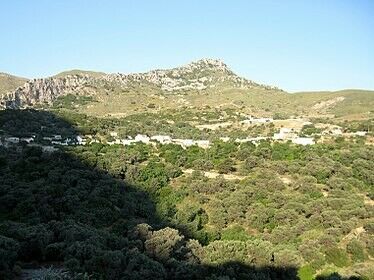"Discover the charm of Drimiskos, where tranquility meets timeless beauty. Immerse yourself in the local culture, unwind by the serene beaches, and experience the allure of this Cretan village."
For the Visitor:
Natural Attractions - Points of Interest
In the very center of the village, the central fountain flows with its cold water, refreshing the villagers and passersby even today. In the past, people used its basins as a natural refrigerator, where nearby shops would store their beverages to keep them cool. The abundant water is not wasted; it is collected through channels and directed into two water tanks used by the villagers to irrigate their gardens. There is also a utility area at the fountain, called the "plustario," where housewives used to wash their family's clothes and do laundry.
Right next to the fountain, the thick shade of the old plane tree, affectionately known as the "gero platano" (old plane tree), provides refreshment to every visitor of the village. Especially during the hot summer days, it is a rare spot to find some coolness.
For those who enjoy walking, the summit of Xiro Oros offers an excellent view in all directions when the weather is good. At the top of the mountain, you will also find the stone-built chapel of Christ. The mountain slopes become quite busy during the hunting season, often resembling battle scenes due to the many hunters.
A closer summit is that of Agios Georgios, which one can reach either on foot or by car. When the weather is clear, the view is breathtaking, encompassing the villages of Mesa Yalia, the Libyan Sea up to Gavdos, and Paximadia. Below the steep cliffs of the rock, there is an inexhaustible water source that refreshes those who visit it.
Further down, there is the beach, the Drymiskian Ammoudi, where some might find better refreshment with a few swims in the sea. The area has developed for tourism and offers taverns and rooms for those thinking of staying for more refreshing days. Right next to Ammoudi, with a properly arranged path, one can visit the Lake of Preveli, perhaps one of the best landscapes on the island. The juxtaposition of the Great River and the Phoenix Forest creates the impression of an exotic environment.
Previously, the villagers would visit the above areas in groups to enjoy the sea and indulge in the "vlychada," which was the purest traditional natural cleanser.
The village was enjoyable not only in the summer months but also during the winter, which was equally mild and pleasant. A vivid example was the visits of shepherds from surrounding villages who rented large areas from the villagers to winter their herds.
These rare scenes existed in the village until August 21, 2008. However, in one day, everything changed, and the efforts of hundreds of years of the residents were destroyed. Only their houses remained standing to witness the incredible destruction caused by the fire. The old plane tree also stood upright, its branches blackened both from age and withering from the spectacle it witnessed. If it could speak, it would probably tell us that it would prefer never to have witnessed such a sight. Everything is black, and everything has turned to ashes. We may say that life goes on, but what continuity can life have when it has no economic prospects for development? How can it be sustained, and how can one hope for something better? What should one invest in to yield returns and profits? These are some of the questions that everyone asks themselves and discusses with fellow villagers. The common conclusion among all is that from now on, they face an unprecedented poverty, which may be complete or relative, and possibly great unhappiness.

